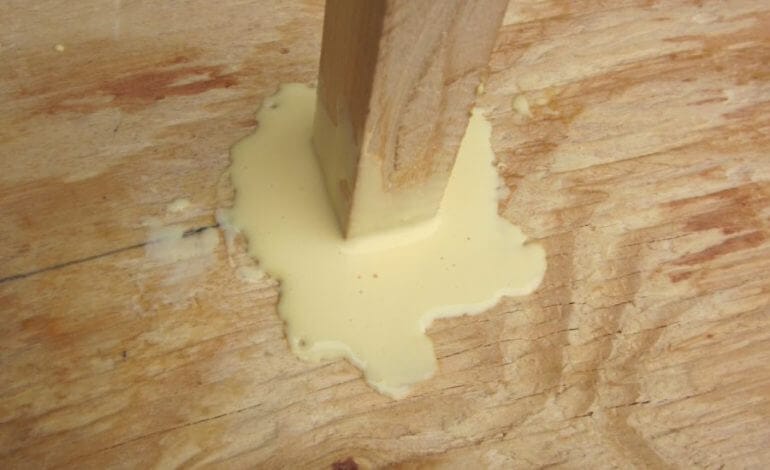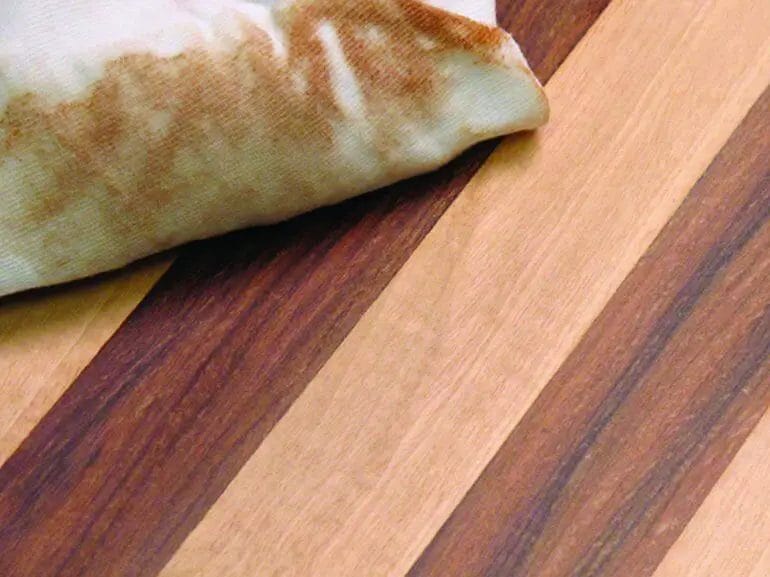If you’ve accidentally spilled acetone on your wooden surface, don’t panic. Acetone is a powerful solvent commonly found in nail polish removers and paint thinners. However, it can also damage the finish and color of your wood if not treated properly. In this guide, we’ll provide you with some effective methods to safely remove acetone from wood, restoring its natural beauty. From using mild solvents to gentle sanding techniques, we’ll help you get rid of acetone stains without causing further damage.
One of the simplest methods to remove acetone from wood is by dabbing a clean cloth or sponge onto the affected area, soaking up as much of the liquid as possible. Then, rinse the area with warm water and mild dish soap to remove any residue. Alternatively, you can use household products like vinegar or rubbing alcohol to gently dissolve the acetone without harming the wood.

If the acetone stain persists, another option is to lightly sand the affected area using fine-grit sandpaper. This method should be used with caution to avoid removing layers of the wood’s finish. After sanding, apply a wood polish or conditioner to restore the shine and protect the surface from further damage.
Remember, prevention is key to avoid future acetone spills. Always work in a well-ventilated area and use protective measures like drop cloths or plastic sheets to prevent accidental spills. By following these simple steps, you can effectively remove

Natural Remedies to Remove Acetone Residue from Wood
Acetone is a commonly used solvent for cleaning and removing stains from various surfaces, including wood. However, if not properly handled, acetone can leave behind residue that can be challenging to remove. In this section, we will explore some natural remedies that can effectively remove acetone residue from wood, leaving it clean and undamaged.
1. Vinegar and Water Solution
Vinegar is known for its powerful cleaning properties and can be an effective solution for removing acetone residue from wood. To prepare the solution, mix equal parts vinegar and water in a spray bottle. Spray the mixture onto the affected area and let it sit for a few minutes. Then, using a soft cloth or sponge, gently scrub the residue in circular motions. Rinse the area with water and dry it thoroughly.
2. Baking Soda Paste
Baking soda is a versatile cleaning agent that can help remove stubborn acetone residue from wood surfaces. Create a thick paste by mixing baking soda with a small amount of water. Apply the paste directly onto the residue and let it sit for approximately 10 to 15 minutes. Then, using a damp cloth, gently rub the paste in a circular motion. Rinse the area with water and wipe it dry.
3. Lemon Juice
Lemon juice is another natural remedy that can effectively break down and remove acetone residue from wood. Squeeze fresh lemon juice onto a clean cloth and gently rub it onto the affected area. Allow the lemon juice to sit for a few minutes, then wipe it off with a damp cloth. Finally, dry the area thoroughly.
4. Olive Oil
Olive oil is not only good for cooking but also for cleaning and conditioning wood surfaces. Apply a small amount of olive oil onto a soft cloth and gently rub it onto the acetone residue. The oil will help loosen the residue, making it easier to remove. Once the residue is lifted, wipe the area with a clean cloth to remove the excess oil.
5. Toothpaste
Toothpaste contains mild abrasives that can help remove acetone residue from wood without damaging the surface. Apply a small amount of non-gel toothpaste onto a soft cloth and gently rub it onto the residue. Use circular motions to work the toothpaste into the wood. Rinse the area with water and wipe it dry.
6. Warm Soapy Water
A simple solution of warm soapy water can also be effective in removing acetone residue from wood surfaces. Fill a bucket or basin with warm water and add a mild dish soap. Dip a soft cloth or sponge into the soapy water and wring out the excess. Gently scrub the residue with the damp cloth, making sure not to saturate the wood. Rinse the area with clean water and dry it thoroughly.
By using these natural remedies, you can effectively remove acetone residue from wood surfaces without the need for harsh chemicals. Remember to always test the remedies on a small, inconspicuous area of the wood before applying them to larger areas to ensure they do not cause any damage.

Step-by-Step Guide to Removing Acetone Stains from Wood
Accidents happen, and sometimes that means spilling acetone on your beautiful wooden furniture or floors. Acetone, commonly found in nail polish remover, can leave unsightly stains on wood surfaces if not cleaned up properly. But don’t worry, with the right steps and a little elbow grease, you can effectively remove acetone stains from wood. In this section, we will provide you with a comprehensive step-by-step guide to help you restore your wood back to its original condition.
Materials You Will Need:
- Soft cloth or sponge
- Mild dish soap
- Water
- Vinegar
- Baking soda
- Olive oil or furniture polish
- Wood stain (if necessary)
Step 1: Act Quickly
The key to successfully removing acetone stains from wood is to act quickly. As soon as the spill occurs, grab a soft cloth or sponge and blot the stain gently. Avoid rubbing the stain as it can spread and penetrate further into the wood.
Step 2: Prepare a Cleaning Solution
Next, prepare a cleaning solution by mixing a small amount of mild dish soap with warm water. Dip a clean cloth into the soapy water and gently dab the stained area. Be careful not to saturate the wood with water, as excessive moisture can cause damage.
Step 3: Vinegar Solution
If the stain persists, create a vinegar solution by mixing equal parts vinegar and water. Dampen a cloth with the solution and gently blot the stain. Vinegar helps to break down and remove the acetone residue from the wood.
Step 4: Baking Soda Paste
If the stain still lingers, make a paste by mixing baking soda with a small amount of water. Apply the paste to the stain and gently rub it in using a soft cloth or sponge. Baking soda acts as a mild abrasive and can help lift stubborn stains from the wood.
Step 5: Rinse and Dry
Once the stain has been successfully removed, rinse the area with clean water to remove any residue from the cleaning solutions. Use a dry cloth to blot the wood and remove any excess moisture. Allow the wood to air dry completely before proceeding to the next step.
Step 6: Restore and Protect
If the acetone stain has caused any damage to the wood’s finish, you may need to restore it. Apply a small amount of olive oil or furniture polish to a soft cloth and gently buff the affected area. This will help restore the shine and protect the wood.
Step 7: Re-stain (if necessary)
If the stain has penetrated deep into the wood and cannot be completely removed, you may consider re-staining the affected area. Choose a wood stain that matches the color of your furniture or floors and follow the manufacturer’s instructions for application.
Summary
Removing acetone stains from wood requires quick action and the right cleaning techniques. By following this step-by-step guide, you can effectively eliminate acetone stains and restore the beauty of your wood surfaces. Remember to act quickly, use the appropriate cleaning solutions, and take necessary steps to protect and restore the wood. With a little effort, your wood will look as good as new!

Preventing and Repairing Acetone Damage on Wooden Surfaces
Wooden surfaces add warmth and beauty to any space, but they can be susceptible to damage, particularly from harsh chemicals like acetone. Acetone, commonly found in nail polish removers, adhesives, and paint thinners, can cause discoloration, staining, and even deterioration of the wood if not handled properly. In this section, we will discuss effective methods for preventing and repairing acetone damage on wooden surfaces.
Preventing Acetone Damage
Prevention is key when it comes to protecting wooden surfaces from acetone damage. Here are some important steps to follow:
- Use protective barriers: Before working with acetone or any other chemical that may harm wood, it is vital to create a protective barrier. Cover the wooden surface with a plastic sheet or foil to prevent direct contact.
- Work in a well-ventilated area: Acetone emits fumes that can be harmful if inhaled. Always work in a well-ventilated area or use a fan to circulate the air.
- Wear protective gloves: When handling acetone, wear protective gloves to avoid direct contact with your skin.
- Clean spills immediately: Accidents happen, and if acetone spills onto a wooden surface, it is essential to act quickly. Dab the spill with a clean cloth or paper towel to remove as much acetone as possible before it seeps into the wood.
Repairing Acetone Damage
If acetone damage has already occurred on a wooden surface, there are steps you can take to repair it:
- Assess the damage: Begin by examining the extent of the acetone damage. Is it a light stain or has the wood started to deteriorate? Understanding the severity will help determine the appropriate repair method.
- Light surface stain: For light surface stains, try gently sanding the affected area using fine-grit sandpaper. This can help remove the stain without causing further damage. After sanding, clean the area and apply a wood polish or sealant to restore the shine.
- Deep penetration or deterioration: If the acetone has deeply penetrated the wood or caused deterioration, more extensive repairs may be necessary. Start by sanding the damaged area to remove any loose or damaged wood. Then, apply a wood filler to fill in any gaps or holes. Once the filler has dried, sand it smooth and apply a matching stain or paint to blend it with the surrounding wood.
- Seek professional help: In cases of severe acetone damage or if you are unsure of how to proceed with repairs, it is best to seek professional help. Professional woodworkers or restoration experts can assess the damage and provide appropriate solutions to restore the wooden surface.
Remember, prevention is always better than cure. By taking precautionary measures and following proper handling techniques, you can minimize the risk of acetone damage on your wooden surfaces. In summary, protect your surfaces with barriers, work in well-ventilated areas, wear protective gloves, and clean up spills promptly. If damage does occur, assess the severity and choose the appropriate repair method, whether it’s light sanding and polishing or more extensive restoration.
Expert Tips for Cleaning Acetone Spills on Wood Furniture
Accidents happen, and if you’ve accidentally spilled acetone on your wood furniture, you may be worried about how to clean it up without causing any damage. Acetone is a powerful solvent that can strip away finishes and even discolor wood if not handled properly. But fear not, with the right techniques and a little know-how, you can effectively clean up acetone spills on wood furniture and restore its original beauty. Here are some expert tips to help you out:
1. Act quickly
When dealing with acetone spills, time is of the essence. The longer the acetone sits on the wood, the greater the chances of damage. As soon as the spill occurs, grab a clean cloth or paper towel and blot the area gently. Avoid rubbing or scrubbing, as this can push the acetone further into the wood and cause more harm.
2. Test in an inconspicuous area
Before using any cleaning solution on your wood furniture, it’s essential to test it in an inconspicuous area to ensure it won’t cause any damage or discoloration. Choose a small, hidden spot and apply a small amount of the cleaning solution. If there are no adverse effects after a few minutes, you can proceed with confidence.
3. Use a gentle cleaning solution
When it comes to cleaning acetone spills on wood furniture, it’s crucial to use a gentle and non-abrasive cleaning solution. A mixture of mild dish soap and warm water is usually sufficient. Mix a few drops of dish soap with warm water in a bowl to create a soapy solution. Dip a clean cloth or sponge into the solution and gently blot the affected area. Always remember to work in small sections and avoid saturating the wood with excessive moisture.
4. Rinse thoroughly
After cleaning the acetone spill, it’s essential to rinse the area thoroughly to remove any leftover soap residue. Dampen a clean cloth with plain water and gently wipe down the treated area. Make sure to remove all traces of soap to prevent any potential damage or discoloration. Once the area is rinsed, use a dry cloth to blot away any excess moisture.
5. Apply a wood polish or wax
After cleaning and thoroughly drying the affected area, it’s a good idea to apply a wood polish or wax to restore the furniture’s natural shine and protect it from further damage. Choose a polish or wax specifically designed for wood furniture and apply it according to the product instructions. Use a clean cloth to evenly spread the polish or wax and buff it gently to achieve a beautiful shine.
6. Seek professional help if necessary
If the acetone spill has caused significant damage to your wood furniture or if you’re unsure about how to proceed, it’s best to seek professional help. Furniture restoration experts have the knowledge and experience to handle acetone spills and can provide you with the best course of action to restore your furniture.
Summary
Accidentally spilling acetone on wood furniture can be a cause for concern, but with the right techniques, you can effectively clean it up without causing any damage. Act quickly, test cleaning solutions in inconspicuous areas, use a gentle cleaning solution, rinse thoroughly, and apply a wood polish or wax to restore and protect your furniture. If needed, don’t hesitate to seek professional help to ensure the best outcome.
Frequently Asked Questions
1. How can I remove acetone from wood?
To remove acetone from wood, start by wiping the affected area with a clean cloth dampened in warm soapy water. Rinse the cloth frequently to avoid spreading the acetone. If the stain persists, try using a mild abrasive like baking soda or toothpaste. Apply the abrasive gently in a circular motion, then wipe clean with a damp cloth.
2. Is it safe to use acetone on wood?
Acetone can be used on wood, but caution should be exercised. Acetone is a strong solvent and can potentially damage the finish or stain on the wood. Always test the acetone on a small, inconspicuous area first to ensure it does not cause any harm. Additionally, make sure to use acetone in a well-ventilated area to avoid inhaling the fumes.
3. Can I use other household items to remove acetone from wood?
Yes, there are several household items that can be used to remove acetone from wood. Some effective options include rubbing alcohol, vinegar, or mineral spirits. Apply the chosen substance to a clean cloth and gently rub the affected area. Make sure to test the substance on a small area first and always follow up with a clean cloth dampened in water to remove any residue.
Conclusion:
In conclusion, removing acetone from wood can be a daunting task, but with the right techniques and precautions, it can be successfully accomplished. Firstly, it is important to act quickly and blot the acetone with a clean cloth or paper towel to prevent it from seeping deeper into the wood. Next, using a mild detergent or vinegar solution and a soft brush, gently scrub the affected area. Rinse with water and dry thoroughly. For tougher stains, sanding the surface or using a specialized wood cleaner may be necessary. Remember to always test any cleaning agent on a small, inconspicuous area of the wood before applying it to the entire surface. With patience and care, you can restore the beauty of your wood furniture or flooring.